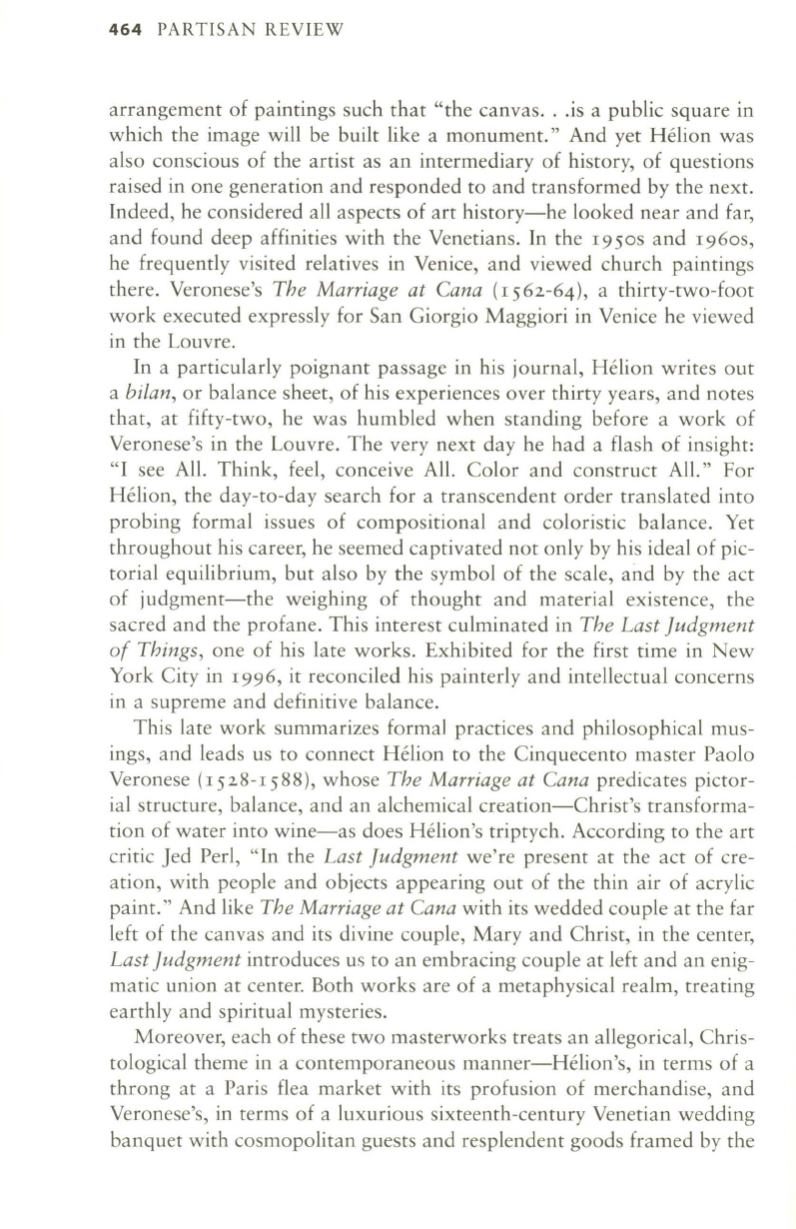
464
PARTISAN REVIEW
arrangement of paintings such that "the canvas . . .is a public square in
which the image will be built like a monument." And yet Helion was
also conscious of the artist as an intermediary of history, of questions
raised in one generation and responded to and transformed by the next.
Indeed, he considered all aspects of art history-he looked near and far,
and found deep affinities with the Venetians. In the
I9
5os and
I 9 60S,
he frequently visited relatives in Venice, and viewed church paintings
there. Veronese's
The Marriage at Cana
(I
5
62-64),
a thirty-two-foot
work executed expressly for San Giorgio Maggiori in Venice he viewed
in the Louvre.
In a particularly poignant passage in his journal, HeIion writes out
a
bilan,
or balance sheet, of his experiences over thirty years, and notes
that, at fifty-two, he was humbled when standing before a work of
Veronese's in the Louvre. The very next day he had a flash of insight:
"I see All. Think, feel, conceive All. Color and construct All." For
HeIion, the day-to-day search for a transcendent order translated into
probing formal issues of compositional and coloristic balance. Yet
throughout his career, he seemed captivated not only by his ideal of pic–
torial equilibrium, but also by the symbol of the scale, and by the act
of judgment-the weighing of thought and material existence, the
sacred and the profane. This interest culminated in
The Last Judgment
of Things,
one of his late works. Exhibited for the first time in New
York City in
I996,
it reconciled his painterly and intellectual concerns
in a supreme and definitive balance.
This late work summarizes formal practices and philosophical mus–
ings, and leads us to connect Helion to the Cinquecento master Paolo
Veronese
(I528 -I588),
whose
The Marriage at Cana
predicates pictor–
ial structure, balance, and an alchemical creation-Christ's transforma–
tion of water into wine-as does Helion's triptych. According to the art
critic Jed Perl, "In the
Last Judgment
we're present at the act of cre–
ation, with people and objects appearing out of the thin air of acrylic
paint. " And like
The Marriage at Cana
with its wedded couple at the far
left of the canvas and its divine couple, Mary and Christ, in the center,
Last Judgment
introduces us to an embracing couple at left and an enig–
matic union at center. Both works are of a metaphysical realm, treating
earthly and spiritual mysteries.
Moreover, each of these two masterworks treats an allegorical, Chris–
tological theme in a contemporaneous manner-Helion's, in terms of a
throng at a Paris flea market with its profusion of merchandise, and
Veronese's, in terms of a luxurious sixteenth-century Venetian wedding
banquet with cosmopolitan guests and resplendent goods framed by the


